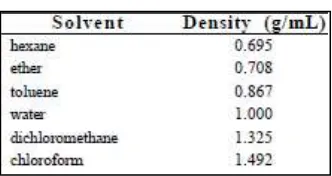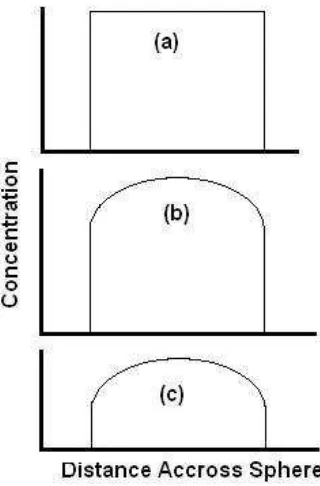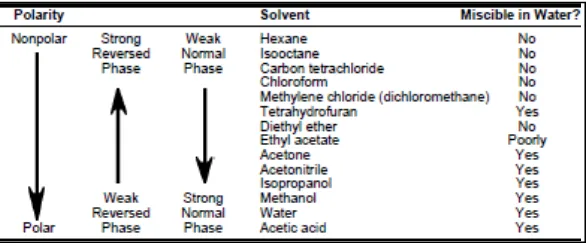UNIVERSITI TEKNIKAL MALAYSIA MELAKA
INVESTIGATION OF EXTRACTING OIL FROM WASTE PALM FRUIT FIBRE
This report submitted in accordance with requirement of the Universiti Teknikal Malaysia Melaka (UTeM) for the Bachelor Degree of Manufacturing Engineering
(Type your Department’s name here) (Hons.)
by
AMIRUDDIN BIN SHAHIPURULLAH B051010101
880923-56-5965
DECLARATION
I hereby, declared this report entitled “Investigation of extracting oil from waste palm fruit fibre” is the results of my own research except as cited in references.
Signature : ……….
Author’s Name : ………
APPROVAL
This report is submitted to the Faculty of Manufacturing Engineering of UTeM as a partial fulfillment of the requirements for the degree of Bachelor of Manufacturing Engineering (Manufacturing Process) (Hons.). The member of the supervisory committee is as follow:
……… (Official Stamp of Supervisor)
i
ABSTRAK
Fiber perahan kelapa sawit ditekan adalah tertakluk kepada pengekstrakan soxhlet (SE) dan pengekstrakan superkritikal karbon dioksida (SC-CO2) pada 80 ˚ C dan
100bar untuk menyiasat peratusan sisa minyak kelapa sawit. Kualiti sisa minyak kelapa sawit dibandingkan dengan minyak sawit mentah (CPO) diekstrak dengan mesin Press. Menurut hasil eksperimen, SE menghasilkan nilai perahan tertinggi OER dengan 11,423% berdasarkan berat kering sampel membandingkan SC-CO2
dengan 1,789%. Kecekapan teknik pengekstrakan SC-CO2 bagi mendapatkan OER
daripada PPF adalah 15.66% pada 100bar dan 80 ˚ C berbanding SE . Walau bagaimanapun dari segi kualiti secara keseluruhan, kualiti minyak dari teknik perahan SC-CO2 adalah lebih baik dari perahan Soxhlet dengan nilai DOBI adalah
ii
ABSTRACT
Fresh palm-pressed fiber was subjected to soxhlet extraction and supercritical carbon dioxide (SC-CO2) extraction at 80 ˚C and 100bar to investigate the residue fiber oil
yield percentage. The residue oil quality compared to the crude palm oil (CPO) extracted with press machine. According to the results, SE resulted in the highest value of OER with 11.423% based on sample dry weight comparing to the SC-CO2
extraction with 1.789%. The efficiency of SC-CO2 extraction techniques for recovery
of OER from PPF was 15.66% at 100bar and 80˚C of those found with SE, respectively. However in term of overall quality. SC-CO2 extraction techniques far
surpass Soxhlet extraction with DOBI of 2.565, PV of 1.58 meq O2/kg, moisture
iii
DEDICATION
iv
ACKNOWLEDGEMENT
v
List Abbreviations, Symbols and Nomenclatures ix
CHAPTER 1: INTRODUCTION 1
1.5.2. Super Critical Fluid Extraction 6
1.5.3. Solid Phase Extraction 9
CHAPTER 2: LITERITURES REVIEW 12
2.1.History of Oil Extraction 12
2.2.The Palm Oil Extraction Process 14
2.2.1. Mechanical Extraction with Press Machine 16
2.2.2. Solvent Extraction with Hexane 19
2.3.Re-Extraction Process 22
2.3.1. Re-Press Extraction 23
vi
2.3.2.1. Cold Extraction Method 30
2.3.2.2. Soxhlet Extraction Method 30
2.3.2.3. Reflux Extraction Method 31
2.3.3. Supercritical Fluid Extraction 25
2.3.3.1. Super Critical Carbon Dioxide 25
CHAPTER 3: METHODOLOGY 28
3.1.Methodology Outline 28
3.2.Experimental Work 29
3.2.1. Sample Preparation 29
3.2.2. Soxhlet Extraction 31
3.2.3. Supercritical CO2 33
3.3.Analysis 35
3.3.1. Deterioration of Bleachability Index (DOBI) 35
3.3.2. Oxidative Stability Index (OSI) 35
3.3.3. Peroxide Value (PV) 37
3.3.4. Free Fatty Acids (FFA) 38
3.3.5. Moisture Content 39
3.3.6. Impurities Content 39
3.3.7. Calculation Steps 12
CHAPTER 4: RESULTS AND DISCUSSION 41
4.1.Results 41
4.2.Comparison between Extraction Techniques 44
4.3.Quality of oil 45
vii
CHAPTER 5: CONCLUSION 52
REFERENCES 53
viii
LIST OF TABLES
Table 1.1: Common Extraction Solvent Listed by Densities 6
Table 1.2: Critical properties of various solvent 6
Table 1.3: Density, Diffusivity and Viscosity for Liquids, 8 Gases and Supercritical Fluids
Table 1.4: Characteristic of solvent used in SPE 10
Table 2.1: Summary of oil extracted from various natural 26
sources using SC-CO2.
Table 3.1: Sample drying sequence 30
Table 4.1: Extraction Result Average of Soxhlet Extraction and 43 SC-CO2 Extraction Method.
Table 4.2: The Deterioration Of Bleachability Index (DOBI), 48 Oxidative Stability Index (OSI), Peroxide Value (PV),
Moisture Content, Free Fatty Acids (FFA) and Impurities in the SC-CO2, Soxhlet and Commercial Extracted Palm Oil.
Table 4.3: DOBI quality level. 49
ix
LIST OF FIGURES
Figure 1.1: SFE extraction concentration profile 7
Figure 1.2: Concentration profile (a) Limited diffusion 8 (b) Limited solubility
Figure 2.1: Crude palm oil extraction process flow chart 14
Figure 2.2: The sectional view of horizontal screw press 16
Figure 2.3: The sectional view of parallel twin-screw press 17
Figure 2.4: Counter-current first extraction 21
Figure 2.5: Counter-current second extraction 21
Figure 2.6: Movement of solution in counter-current extraction 21
Figure 3.1: Outline of the overall methodology. 29
Figure 3.2: Sample selection process. 30
Figure 3.3: Schematic diagram of the supercritical fluid extraction unit. 34
Figure 3.4: Supercritical fluid extraction laboratory scale. 34
Figure 3.5: (a) Oxidative Stability Index (OSI) equipment 36 (b) Schematic diagram of the Oxidative Stability Index (OSI) equipment.
x
Figure 3.7: Titration process, the flask shaked hardly until the blue 38 color gone.
Figure 4.1: Graft of Oil extraction observation on three different 43 operating press.
Figure 4.2: Graft of DOBI observation on three different 43 operating press.
Figure 4.3: Graft of FFA constitution observation on three different 44 operating press.
Figure 4.5: Graft of impurities content observation on three different 44 operating press.
Figure 4.6: Graft of moisture content observation on three different 45 operating press.
xi
LIST OF ABBREVIATIONS, SYMBOLS AND NOMENCLATURE
Bp - Boiling Point
DOBI - The Deterioration of Bleachability Index
EFB - Empty Fruit Bunches
FFA - Free Fat Acid
FFB - Fresh Fruit Bunch
H2O - Water
K - Distribution Coefficient OSI - Oxidative Stability Index
PPF - Palm Pressed Fibre
PV - Peroxide Value
SC-CO2 - Supercritical Carbon Dioxide
SCF - Supercritical Fluid
1
CHAPTER 1
INTRODUCTION
In this chapter contain the introduction of the research. This research has been carried based on the residue from Sime Darby Nordanal Palm Oil Mill that situated at Muar, Johor. Problem statement, objectives, scopes of this research and the theory also discussed in this chapter. There are also consisting of chapter organization that explains further about overall chapter in this report.
1.1 Research Background
The palm oil tree (Elais guineensis) originated from West Africa and was introduced in Malaysia in early of 1870’s. Palm oil plant covers 67% of Malaysia’s total agricultural land with 3 million hectares of the trees under cultivation, and 500,000 people in Malaysia are engaged in the sector. Today Malaysia is the largest producer and exporter of palm oil in the world. According to Malaysian Palm Oil Council currently we are producing 50% of world palm crude edible oil and acccount 62% of world exports.
2
oil sludge (decanter cake), empty fruit bunches, palm shell, and palm pressed fiber as residues.
An oil palm fiber is one of residue that has been produced after processing of crude palm oil take place. Oil Palm Fibres can be used by manufactures to make various fibre composites such as furniture, infrastructures, and mattress. The oil palm fibre is produced from empty fruit bunches (EFB) that are considered as waste after the extraction oil palm fruits. However there are some problems regarding to this waste. Laboratory testing finds that there still has oil in the fibre range at 5 - 7%. Therefore, in this research, there are some suggestions that can reduce oil loss in the oil palm fibre.
To become the useable fibre, the empty fruit bunches goes through process which involve empty fruit bunches to be shredded, separated, refined and dried. No chemicals were involved in the production of oil palm fibres. High quality oil palm fibres are clean and toxic free. After the process, the end product of high quality oil palm fibre can be used by manufactures to make various fibre composites such as furniture, infrastructures, mattress, erosion control, paper production and also landscaping.
1.2 Problem Statement
3
1.3 Objectives
The aim of this research is to propose some technique to reduce the oil lost by extracting the residue oil from the pressed palm fibre. Hence the specific objectives of the research are:
To investigate the percentage of oil in palm pressed residue.
To extract residue oil from pressed palm oil fibre with the Soxhlet extraction method.
To compare oil quality.
1.4 Scope of Work
4
1.5 Theory
1.5.1 Solution Extraction
Solvent extraction is a process whereby two immiscible liquids or substance are added up and vigorously shaken in an attempt to disperse one in the other so that solutes can migrate from one solvent to the other. When the two liquids are not shaken the solvent to solvent interface area is limited to the geometric area of the circle separating the two solvents. However as the two liquids are vigorously shaken the solvents become intimately dispersed in each other. In general, a solution will be distributed, or partitioned between both available phases. An equilibrium distribution will be reached, and the equilibrium constant for this process is called the distribution coefficient, or sometimes the partition coefficient.
1.5.1.1 Distribution Coefficient
The distribution coefficient is a measure of the tendency for the solute to reside in one phase versus the other and, to a very good approximation, is equal to the ratio of solubilities for A in the respective solvents. Thus, if A is much more soluble in water than in the organic solvent, the distribution coefficient will be small (<1), while a large distribution coefficient implies that A is much more soluble in the organic than in water. You should note that it is the concentration in each phase which is important, so that the quantity of A which is found in each phase will also depend on the volumes of solvent involved.
K=
5
Those compounds with very large (say, >20) or very small (<0.05) distribution coefficients will be found nearly totally in one of the phases. In contrast, for compounds with intermediate values for the distribution coefficient, the distinction between phases is not so clear-cut. Significant amounts of material will be found in each phase.
1.5.1.3 Choosing a Solvent System
One important aspect when choosing a solvent system for extraction is to pick two immiscible solvents. Some common extraction solvent pairs are water-dichloromethane, water ether, and water-hexane. Most extractions involve water because it is highly polar and immiscible with most organic solvents. In addition, the compound you are attempting to extract must be soluble in the organic solvent, but insoluble in the water layer. An organic compound like benzene is simple to extract from water, because its solubility in water is very low. However, solvents like ethanol and methanol will not separate using liquid/liquid extraction techniques, because they are soluble in both organic solvents and water.
There are also practical concerns when choosing extraction solvents. Cost, toxicity, flammability should be considered. The volatility of the organic solvent is important. Solvents with low boiling points like ether and hexane are often used to make isolating and drying the isolate material easier. If ether is used (bp = 35 °C) then evaporation to collect the solid is fast.
1.5.1.4 Identifying the Layers
6
is 1.325 g/mL and water is 1.000 g/mL. Dichloromethane is more dense that water; therefore, dichloromethane will be the bottom layer and water will be the top layer. Table 1 lists the densities of some extraction organic solvents.
Table 1.1: Common Extraction Solvent Listed by Densities (Solution Extraction, page 76)
1.5.2 Super Critical Fluid Extraction
Supercritical Fluid Extraction (SFE) is the process of separating one component from another using supercritical fluid as the extracting solvent. Extraction is usually from a solid matrix, but can also be from liquids. SFE can be used as a sample preparation step for analytical purposes, or on a larger scale to either strip unwanted material from a product or collect a desired product.
Table 1.2: Critical properties of various solvent (Reid et al, 1987)
7
Ethane (C2H6) 30.07 305.3 4.87;48.1 0.203
Propane (C3H8) 44.09 369.8 4.25;41.9 0.217
Ethylene (C2H4) 28.05 282.4 5.04;49.7 0.215
Propylene (C3H6) 42.08 364.9 4.60;45.4 0.232
Methanol (CH3OH) 32.04 512.6 8.09;79.8 0.272
Ethanol (C2H5OH) 46.07 513.9 6.14;60.6 0.276
There are two essential steps to SFE, diffusion of solution with the solid particles to the surface, and dissolution in the supercritical fluid. Clifford, Tony. (1999) say Figure 1.1 shows the stages during extraction from a spherical particle where at the start of the extraction the level of extracting is equal across the whole sphere shown on Figure 1.1a. As extraction started, the material is initially extracted from the edge of the sphere, and the concentration in the center is unchanged as shown on Figure 1.1b. As the extracting diffuses towards the edge of the sphere, the concentration in the center of the sphere drops as shown on Figure 1.1c.
8
Clifford, Tony. (1999) also say Figure 1.2 is illustrating two extreme cases of the relative rates of diffusion and dissolution. Dissolution is fast relative to diffusion case shown on Figure 1.2a. The concentration at the edge drops to zero caused by the rate of the material is carried away from the edge is faster than it can diffuse from the center. The material is carried away as fast as it arrives at the surface, and the extraction is completely diffusion limited. Figure 1.2b shows a case where solubility is low relative to diffusion. The extracting is able to diffuse to the edge faster than it can be carried away by the solvent, and the concentration profile is flat.
Figure 1.2: Concentration profile (a) Limited diffusion (b) Limited solubility (Clifford, Tony.
1999).
Supercritical fluid extraction incomparision with liquid extraction are relatively faster because of the low viscosities and high diffusivities associated with supercritical fluids. The extraction can be selective to some extent by controlling the density of the medium and the extracted material is easily recovered by simply depressurizing, allowing the supercritical fluid to return to gas phase and evaporate leaving no or little solvent residues.
Table 1.3: Density, Diffusivity and Viscosity for Liquids, Gases and Supercritical Fluids
Density (kg/m3) Viscosity (µPa.s) Diffusity (mm2/s)
Gases 1 10 1-10
Supercritical Fluids 100-1000 50-100 0.01-0.1
9 1.5.3 Solid Phase Extraction
Solid-phase extraction (SPE) is nonequilibrium, exhaustive removal of chemical constituents from a flowing liquid sample via retention on a contained solid sorbent and subsequent recovery of selected constituents by elution from the sorbent. M.J.M. Wells et al, (2000) say analytical laboratories use solid phase extraction to concentrate and purify samples for analysis. Solid phase extraction can be used to isolate analytes of interest from a wide variety of matrices, including urine, blood, water, beverages, soil, and animal tissue.
1.5.3.1 Normal Phase SPE
Normal phase SPE procedures typically involve a polar analyte, a mid- to nonpolar matrix and a polar stationary phase. Polar-functionalized bonded silicas and polar adsorption media typically are used under normal phase conditions. Retention of an analyte under normal phase conditions is primarily due to interactions between polar functional groups of the analyte and polar groups on the sorbent surface. These include hydrogen bonding, pi-pi interactions, dipole interactions, and dipole-induced dipole interactions, among others. A compound adsorbed by these mechanisms is eluted by passing a solvent that disrupts the binding mechanism, usually a solvent that is more polar than the sample’s original matrix.
1.5.3.2 Reversed Phase SPE
10
van der Waals forces, or dispersion forces. To elute an adsorbed compound from a reversed phase SPE tube or disk, use a nonpolar solvent to disrupt the forces that bind the compound to the packing.
Polymeric bonding is more resistant to pH extremes, and thus is more suitable for environmental applications for trapping organic compounds from acidified aqueous samples. All silica based bonded phases have some percentage of residual unreacted silanols that act as secondary interaction sites. These secondary interactions may be useful in the extraction or retention of highly polar analytes or contaminants, but may also irreversibly bind analytes of interest.
Table 1.4: Characteristic of solvent used in SPE (Bulletin 910, 1998, page 8)
1.5.3 Ion Exchange SPE
Ion exchange SPE can be used for compounds that are charged when in a solution (usually aqueous, but sometimes organic). The primary retention mechanism of the compound is based mainly on the electrostatic attraction of the charged functional group on the compound to the charged group that is bonded to the silica surface. In order for a compound to retain by ion exchange from an aqueous solution, the pH of the sample matrix must be one at which both the compound of interest and the functional group on the bonded silica are charged. Also, there should be few, if any, other species of the same charge as the compound in the matrix that may interfere with the adsorption of the compound of interest.



